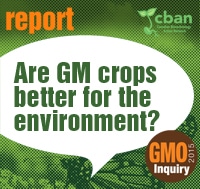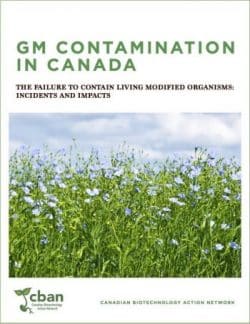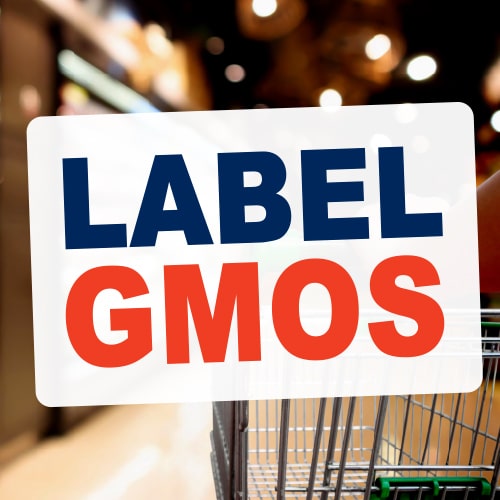Désolé, la version française de cette page ne peut être offerte pour le moment.
Environmental Impacts
The early warnings of environmentalists about the negative impacts of genetically engineered (genetically modified (GM) plants are being proven correct. We are now observing the following problems:
- Increased Herbicide Use: The widespread cultivation of GM herbicide-tolerant crops has pushed up the use of herbicides such as glyphosate. Herbicide sales in Canada have increased by 270% since GM crops have been introduced (1994-2023).
- « Superweeds »: The use of specific herbicides with GM herbicide-tolerant crops has led to the evolution and spread of « superweeds, » or weeds that can no longer be killed by those herbicides. Since 1996, 59 weed species have developed resistance to the herbicide glyphosate.
- « Superpests »: Some insects have developed resistance to the toxins in GM insect-resistant (Bt) crops. The first case in Canada was reported in May 2019.
- Contamination: Contamination from GM plants has serious ecological, economic and social impacts. Gene flow from GM crops poses a threat to wild and weedy crop relatives, non-GM crops and foods, and organic farming. There have been escape events in Canada with GM canola, flax, wheat and pigs.
- Biodiversity Loss: The use of some GM crops can have negative impacts on non-target organisms and on soil and water ecosystems. For example, the expansion of GM herbicide-tolerant corn and soy, which are twinned with herbicides, has destroyed much of the habitat of the monarch butterfly in North America.
Increased Pesticide Use
Herbicide-Tolerant Crops and Herbicide Use
100% of the GM crops currently grown in Canada – corn, soy, canola, sugar beet and alfalfa – are engineered to be tolerant to one or more specific herbicides. Most are tolerant to multiple herbicides. Glyphosate is the top pesticide ingredient sold in Canada, and its use tripled between 2005 and 2011. Between 1994 and 2023, herbicide sales in Canada increased by 270%.
CBAN Factsheet: Genetically engineered crops have increased herbicide use, May 2024.
Insect-Resistant Crops and Pesticide Use
GM insect-resistant (Bt) crops are engineered to produce a toxin that makes the entire plant toxic to certain insect pests however GM Bt toxins have been shown to impact insects that are not the intended targets. For example, spiders, wasps, ladybugs, and lacewings, which are predators that eat Bt-targeted insects, were negatively affected by ingesting prey that had consumed GM Bt toxins. The use of GM Bt corn decreased the use of insecticides, however, the GM plant produces almost as much, or more, insecticide (endotoxin) itself as would have been applied externally. Insecticide use is now rising as insects become resistant to GM Bt toxins. The total number of pesticides (herbicides, insecticides and fungicides) applied to corn fields in North America increased from approximately 4 per hectare in 1996 when GM crops were introduced, to over 13 in 2023.
CBAN Factsheet: Genetically engineered Bt insect-resistant corn poses human health risks, May 2024
Herbicide-Resistant Weeds
One of the consequences of the increased use of specific herbicides with GM herbicide-tolerant crops has been the emergence and spread of herbicide-resistant (HR) weeds, or “superweeds”. These are weeds that develop resistance to certain herbicides when they are widely and frequently applied.
The emergence of herbicide-resistant weeds predates GM crops. The first instances of herbicide-resistant weeds were observed in the 1950s with the introduction and wider use of industrial farming methods and chemical herbicides. As herbicide use has increased, so has the number and range of herbicide-resistant weeds. GM crops have accelerated and entrenched this pattern because the introduction of herbicide-tolerant crops, particularly glyphosate-tolerant “Roundup Ready” crops, has meant that large areas of cropland are repeatedly sprayed with the same herbicide. There are currently 59 species of weeds that are tolerant to glyphosate around the world. Eight of these species are found in Canada, and 18 of them are found in the US.
Herbicide resistant weeds also present economic costs for farmers. In the US, weed management costs in infested fields is 50-100% higher per hectare than in those without glyphosate-resistant weeds. Some weeds have developed resistance to multiple herbicides, making them even harder to control. The spread of HR weeds in turn drives up herbicide use, leading to a « pesticide treadmill » that has serious impacts on the environmental and human health.
In order to combat glyphosate-resistant weeds, companies are “stacking” multiple GM herbicide-tolerant traits together in the one seed so that farmers can spray other herbicides on their GM crops. For example, Canada approved the first GM corn tolerant to the herbicide 2,4-D in 2012; the first GM corn tolerant to dicamba in 2016; and then, in 2020, a GM corn tolerant to both 2,4-D and dicamba. Most of these products are also tolerant to glyphosate. Approximately 80% of GM corn products on the market in Canada in 2023 were tolerant to more than one herbicide. Click here for more information on 2,4-D- and dicamba-tolerant crops.
Superbugs
In May 2019, it was reported that corn farmers in Canada are observing that the European corn borer, an insect pest, has developed resistance to the genetically engineered (genetically modified or GM) trait designed to kill it. This is the first report in the world of the European corn borer (ECB) developing resistance to a genetically engineered trait used to confer insect resistance. It is also the first report in Canada of any insect pest developing resistance to a genetically engineered trait.
Press Release – June 11, 2019: First Canadian Case of Insect Resistance to Genetically Engineered Corn Discovered
The development of resistance in other insect pests targeted by Bt (Bacillus thuringiensis) traits in corn has been observed in the U.S., South Africa and Brazil. Additionally, in the U.S. and other countries, some cotton pests have also developed resistance to Bt cotton traits.
A 2023 study that studied published cases of Bt resistance found 26 cases of resistance to Bt crops by 2020, involving 11 insect species in seven countries, up from 3 cases in 2005. Several other cases showed signs of early resistance.
Contamination
CBAN Report – 2019: GM Contamination in Canada: The failure to contain living modified organisms – incidents and impacts »
Once released into our environment, genetically engineered (also called genetically modified or GM) organisms are difficult or impossible to control or recall. Each release of a GM organism is an experiment – some are more controlled and controllable than others.
GM contamination is the unwanted escape and spread of GMOs or genetic material from GMOs to non-GM plants, animals and foods. This dispersal can occur through a number of ways, including pollen spread and seed escape, and mixing of food and feed. GM contamination is living pollution that can self-replicate. Such contamination can have negative environmental, social and economic impacts. So far, the impacts have been economic and social – so far, farmers have been the first to pay the price of GM contamination.
There have been escape events in Canada with GM canola, flax, wheat and pigs.
- Some escape events occurred with GMOs approved by our government (canola and flax), and others with experimental unapproved GM plants and animals (wheat and pigs).
- Some were isolated incidents (wheat and pigs), while others are widespread or ongoing contamination cases (canola and flax).
For more information, see our report or our webpage on contamination.
Biodiversity
- Herbicide-tolerant cropping systems have encouraged the use of herbicides that reduce overall plant diversity in agricultural systems and can limit habitat and food sources for other important organisms.
- Insect-resistant (Bt) crops are toxic to certain classes of insects and can harm non-target insects.
Monarch butterfly decline and GM glyphosate-tolerant crops
Milkweed decline is strongly correlated with the use of herbicide-resistant crops.” Committee on the Status of Endangered Wildlife in Canada (COSEWIC), Assessment and Status Report on the Monarch (Danaus plexippus) in Canada, 2016. In 2023, the Monarch butterfly was now listed as an Endangered species in Canada. Monarch butterfly populations have declined by more than 90% in under 20 years. It is estimated that the butterflies may have lost more than 165 million acres of habitat in this time-frame largely due to the increase in the use of the herbicide glyphosate, which kills the common milkweed that the butterfly needs to breed.
- Click here to read more information on the connection between GM glyphosate-tolerant crops and the decline of the monarch butterfly.
- Genetically engineered crops have increased herbicide use, May 2024
- cban.ca/pesticides
Bt harm to non-target insects
Genetically engineered insect-resistant (Bt) crops are engineered to produce a toxin that makes the entire plant toxic to certain insect pests however GM Bt toxins have been shown to impact insects that are not the intended targets. For example, spiders, wasps, ladybugs, and lacewings, which are predators that eat Bt-targeted insects, were negatively affected by ingesting prey that had consumed GM Bt toxins. The use of GM Bt corn decreased the use of insecticides, however, the GM plant produces almost as much, or more, insecticide (endotoxin) itself as would have been applied externally. Insecticide use is now rising as insects become resistant to GM Bt toxins. The total number of pesticides (herbicides, insecticides and fungicides) applied to corn fields in North America increased from approximately 4 per hectare in 1996 when GM crops were introduced, to over 13 in 2023. CBAN Factsheet: Genetically engineered Bt insect-resistant corn poses human health risks, May 2024
Pollen and other plant parts containing toxins from genetically engineered insect-resistant (Bt) corn are washing into streams near cornfields. Lab trials showed that consumption of Bt corn byproducts produces increased mortality and reduced growth in caddisflies, aquatic insects that are related to the pests targeted by the toxin in Bt corn.
Non-Target Effects
The Nature Institute has established a project called « Nontarget Effects of Genetic Manipulation » (2009-2019) to « make evidence about the wide-ranging and never wholly predictable effects of genetic engineering readily accessible to concerned citizens, policy makers, and scientists. » Click here to read their introductory paper « Understanding the Nontarget Effects of Genetic Manipulation. »
« When foreign genes are introduced into an organism, creating a transgenic organism (commonly called a genetically modified or genetically engineered organism), the results for the organism and its environment are almost always unpredictable. The intended result may or may not be achieved in any given case, but the one almost sure thing is that unintended results – nontarget effects – will also be achieved…Nontarget effects within the host organism are not necessarily due only to the gene directly related to the intended effect. There are numerous ways in which the genetic manipulation can affect changes in the host organism. Although the genetic intervention may seem simple, in reality one is dealing with a complex web of relations that can be altered in manifold ways. »
Conservation
CBAN Flyer: Genetic Engineering for Conservation? May 2025
Genetic engineering is being proposed as a conservation tool – to remove invasives, restore endangered species and bring extinct species back to life. Biotechnology companies also promise to develop genetically modified organisms (GMOs) to replicate “ecosystem services” that society needs, such as for food and fuel, removing our dependence on functioning ecosystems. However, these proposals come with very serious risks, could alter entire ecosystems, and once released, cannot be recalled or reversed. Most often, these proposals also support corporate agendas.
“If permanent, far-reaching and inheritable genetic modifications of wild organisms, which go far beyond previous human interventions, become a reality and are accepted as legitimate instruments of nature conservation, the idea of protecting nature turns into the idea of re-designing nature.” – Federal Agency for Nature Conservation, Federal Republic of Germany, Genetic engineering, nature conservation and biological diversity: Boundaries of design, 2022.
Researchers at the State University of New York College of Environmental Science and Forestry want government approval in the US and Canada to plant a genetically engineered (GE) American chestnut tree in forests. They have genetically engineered an American chestnut that they claim can survive the blight that decimated populations in the 20th century. Their goal is to release this genetically engineered tree into the wild, to “restore” the endangered species by allowing it to cross-pollinate with remaining wild trees. If approved, this GE tree would be the first-ever genetically engineered plant released with the purpose of spreading freely through wild ecosystems. It will be difficult or impossible to track where the GE tree spreads or recall it once released. The GE chestnut’s release would be a large-scale open-air experiment because we do not know how it will impact other forest trees, plants and animals. The ability of this GM tree to function as intended, and its impacts on forest ecosystems, will only be known after decades, centuries, or millennia, CBAN Factsheet: Proposed Release of Genetically Engineered American Chestnut Trees, March 2025.
For more information see cban.ca/conservation
Resources
- Genetic Engineering for Conservation? May 2025
- Proposed Release of Genetically Engineered American Chestnut Trees, March 2025
- Genetically engineered Bt insect-resistant corn poses human health risks, May 2024
- Genetically engineered crops have increased herbicide use, May 2024
- CBAN briefing – Comments on the proposed federal Sustainable Agriculture Strategy, 2023
- GM Contamination Update: Animals, February 2022
- CBAN article – “Enhancing” Trees and Fixing Ecosystems with Genetic Engineering, Watershed Sentinel. 2022
- Are GM Crops Better for the Environment? GMO Inquiry CBAN report, May 2015





